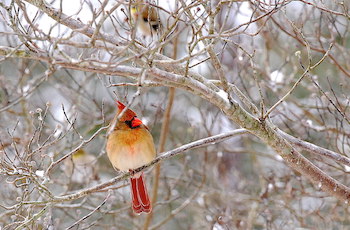
By Terry W. Johnson
Winter is our harshest season of the year. Yet seasonal shows, songs such as Winter Wonderland and even Christmas cards portray a far different image. Snow-covered landscapes are beautiful and offer great places for us to enjoy traditional winter activities such sliding down snowy hillsides and building snowmen.
However, for our backyard wildlife neighbors, winter is far from idyllic. In fact, throughout winter many birds and other wild animals daily face a struggle to survive.
Ironically, winter is also a time of year when scores of wildlife—especially birds—make our yards their home. More species of seed-eating birds inhabit our yards in winter than at any other time. Among the migratory birds that can be seen in backyards during this season are purple finches, pine siskins, fox sparrows, dark-eyed juncos, red-breasted nuthatches, white-throated sparrows and hermit thrushes, to name but a few.
In spite of this, most of our backyard wildlife residents and visitors find it difficult to find enough of the right food, water and cover they need to survive until spring.
Here are some of the challenges facing birds in winter. They have to deal with the coldest weather of the year. To survive to survive the cold, they must eat enough fuel to keep themselves from freezing. Yet the short days of winter offer less time to forage. This problem is compounded because competition for limited food supplies is often high as the permanent residents of our backyards vie for food with birds that are only here in the winter.
Severe weather has a tremendous impact on bird survival in the winter. Ground-feeding birds are especially hard-hit when snow and ice covers their food supply. Larger ground-feeding birds are better able to survive without food than smaller birds.
Extended periods of harsh weather can also adversely affect birds that forage for food in trees. This was dramatically illustrated when five days of freezing rain fell over a large portion of the Northeast and Quebec, followed by a number of days when the temperature did not rise above 14 degrees Fahrenheit.
Data collected during the 2018–2019 Christmas Bird Count in this neck of the woods revealed that populations of black-capped chickadees, downy and hairy woodpeckers, blue jays, and brown creepers had plummeted 20–40 percent.
To help our backyard wildlife deal with the rigors of winter, Georgia DNR’s Wildlife Conservation Section and The Garden Club of Georgia Inc. are encouraging homeowners to improve winter wildlife habitat in their yards with the launch of a new component to the Community Wildlife Project called Creating a Winter Wildlife Wonderland.
For well more than two decades, the Community Wildlife Project has promoted sound wildlife conservation efforts on lands shared by humans and wildlife. A focal point is demonstrating to homeowners a variety of ways in which they can improve the beauty of their yards while at the same time enhancing their value to wildlife. With the addition of Creating a Winter Wonderland, homeowners can now earn certification in five categories: The other four categories are Backyard Wildlife Habitat, Hummingbird Haven, Backyard Nest Boxes and Gardening with Georgia Native Plants.
The Winter Wonderland emphasizes providing appropriate sources of cover, water and food.
Birds and other wildlife require safe and warm places to escape predators and harsh weather (frigid temperatures, rain, snow and ice), as well as relatively dry and warm spots to roost at night. Many yards lack the cavities or thick, leafy shrubs that meet this need. In addition, many invertebrates, mammals, reptiles and amphibians find it difficult to find places to spend the winter (e.g., dead vegetation, rocks, brush piles and the like).
With regards to water, few birdbaths or others sources of water are available are maintained during the winter. As a result, birds are often forced to fly long distances to drink and maintain their feathers. Such flights force birds to burn up much-needed fuel and expose them to increased predation. The truth of the matter is you can often attract more wildlife to your backyard in winter with water than with food.
While many of us feed birds in the winter, some species of birds often find our offerings unappealing. By expanding the menu at our backyard bird diners we can increase the variety of birds that visit them. This is especially true for birds that typically eat insects and other invertebrates as well as fruits and berries. Precious few yards contain trees and shrubs that bear berries and fruits that persist throughout winter.
For more information on how you can transform your yard into a winter haven for wildlife, contact Melissa Hayes at melissa.hayes@dnr.ga.gov. Melissa will be more than happy to send you all you need to certify your yard in the Creating a Winter Wildlife Wonderland project. You can also learn more about the Community Wildlife Project at the Garden Club of Georgia.
If you are interested in making your backyard more hospitable to your wildlife neighbors in winter, don't put it off: Enroll your yard in the Creating a Winter Wildlife Wonderland initiative.
Terry W. Johnson is a former Nongame program manager with the Wildlife Resources Division and executive director of The Environmental Resources Network, or TERN, friends group of the division’s Nongame Conservation Section. (Permission is required to reprint this column.) Learn more about TERN, see previous “Out My Backdoor” columns, read Terry’s Backyard Wildlife Connection blog and check out his latest book, “A Journey of Discovery: Monroe County Outdoors.”





